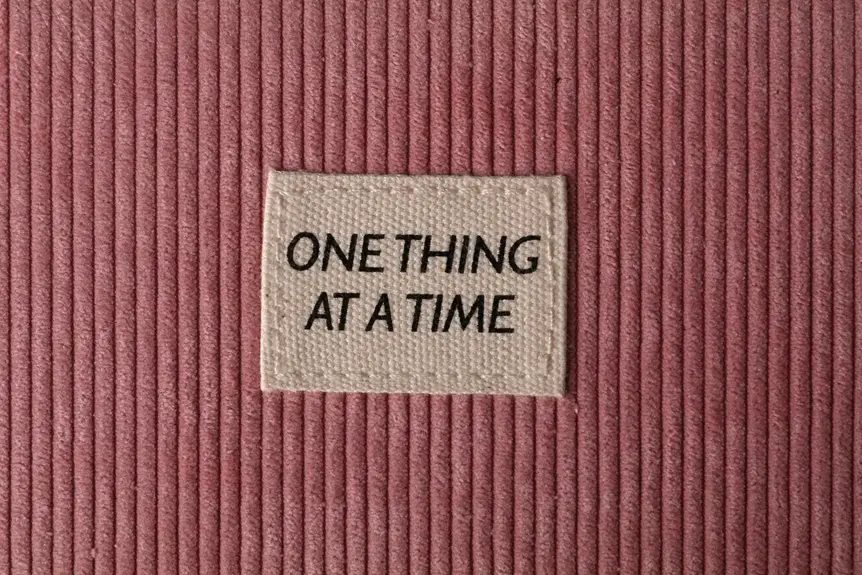When sewing corduroy, you’ll want to start by choosing the right wale width and fabric weight for your project. Use sharp scissors and cut pile-side up, one layer at a time to protect the texture. Pick a universal or denim needle and a longer stitch length to avoid crushing the ridges. Press seams gently on the wrong side with a cloth, and sew with the nap for the best finish. Keep going to uncover more tips and creative ideas for working with corduroy.
Table of Contents
Key Takeaways
- Choose the right corduroy type by wale width and fabric weight to match your project’s texture and durability needs.
- Use universal or denim needles sized 90/14 to 100/16 for sewing, avoiding fine needles to prevent fabric damage.
- Cut corduroy pile-side up with sharp tools, cutting single layers carefully to maintain pile integrity and fabric alignment.
- Pre-wash fabric to prevent shrinkage, align grain lines accurately, and use gentle pinning and marking methods.
- Employ longer stitch lengths, sew with the nap, use a walking foot, and press seams gently with a pressing cloth.
Understanding Corduroy Fabric Types and Textures
Although corduroy might look uniform at first glance, you’ll find a variety of fabric types and textures that affect both its appearance and how you sew it.
The most common distinction lies in the width of the wales—the vertical ribs. Fine wale corduroy has thin, closely spaced ribs, giving it a smoother feel and more delicate look. Wide wale corduroy, on the other hand, has thicker ribs and a chunkier texture, adding bold visual interest but requiring careful needle and thread choices.
You’ll also encounter stretch corduroy, blended with elastane for flexibility, which behaves differently under the needle. Understanding these variations helps you pick the right sewing techniques, stitch length, and handling methods to get the best finish on your corduroy projects.
Essential Tools and Materials for Sewing Corduroy
To sew corduroy successfully, you’ll need to pick the right fabric type and texture for your project.
Using the proper sewing needles and strong thread will help your stitches hold up well.
Let’s explore which tools and materials work best to get your corduroy sewing just right.
Fabric Types and Selection
Choosing the right corduroy fabric sets the foundation for a successful sewing project. You’ll want to take into account the wale size, weight, fiber content, stretch, and color to make sure your project turns out just right.
Different corduroys suit different garments and uses, so picking wisely saves you time and frustration.
Keep these fabric types and selection tips in mind:
- Wale size: Fine wales for delicate garments; wide wales for durability and texture.
- Weight: Lightweight corduroy for shirts; heavier for jackets or pants.
- Fiber content: Cotton blends offer softness; synthetics add stretch and resilience.
- Stretch: Stretch corduroy enhances comfort and fit.
- Color and pattern: Choose hues that match your style and project needs.
Selecting thoughtfully leads to beautiful, long-lasting creations.
Recommended Sewing Needles
Once you’ve selected the perfect corduroy fabric, you’ll want the right sewing needles to handle its texture and thickness.
Use a universal needle in size 90/14 or 100/16 to penetrate the dense ribs without causing damage. If your corduroy is particularly thick or heavyweight, opt for a denim or jeans needle, which has a stronger, sharper point designed to pierce tougher fabrics.
Avoid using fine or sharps needles, as they can bend or break easily when working with corduroy’s piled surface. Change your needle regularly to maintain clean stitches and prevent skipped stitches or fabric snags.
Proper needle choice guarantees smooth sewing and helps preserve your fabric’s unique texture throughout your project.
Thread and Notions Choices
Anyone working with corduroy knows that selecting the right thread and notions is vital for a polished finish. You want durable thread that complements the fabric’s texture without overpowering it. Polyester thread works best because it offers strength and slight stretch.
When it comes to notions, choosing the right tools guarantees your project holds up well and looks professional. Here’s what you’ll need:
- Polyester thread in matching or contrasting colors
- Sharp fabric scissors for clean cuts
- Clips instead of pins to avoid marks
- A sturdy zipper or buttons suited for thick fabric
- Tailor’s chalk or fabric markers for precise markings
Using these materials will help you handle corduroy confidently and achieve the best results every time.
Preparing Corduroy Fabric for Cutting and Sewing
Before you start cutting and sewing, make sure to pre-wash your corduroy to prevent shrinkage later.
Pay close attention to aligning the grain line correctly for a smooth finish.
Use appropriate marking tools and pin carefully to keep the fabric in place as you work.
Pre-washing Techniques
Three essential steps can help you pre-wash corduroy fabric effectively to prevent shrinkage and preserve its texture.
First, always check the care label for specific washing instructions. Next, wash your corduroy in cold water on a gentle cycle to avoid damaging the pile. Finally, avoid using harsh detergents or bleach, which can weaken fibers.
When pre-washing, remember to:
- Turn the fabric inside out to protect the pile
- Use a mild detergent designed for delicate fabrics
- Skip fabric softeners that can flatten the texture
- Avoid overloading the washing machine for even cleaning
- Air dry flat or hang to dry, steering clear of high heat
Following these steps keeps your corduroy soft, vibrant, and ready for sewing.
Grain Line Alignment
Proper grain line alignment plays an essential role in ensuring your corduroy garment hangs correctly and maintains its shape.
When preparing your fabric, lay it flat with the nap running in the same direction to avoid shading differences. Identify the lengthwise grain, which runs parallel to the fabric’s selvage, and align your pattern pieces accordingly. This prevents unwanted stretching or distortion during wear.
Because corduroy has distinct ridges, make sure the grain line on your pattern matches the fabric’s ribs. Use a ruler or straight edge to check that the grain line is perfectly straight before cutting.
Taking these steps helps your finished piece look polished and professional, giving your corduroy project durability and a clean drape.
Marking and Pinning
Once you’ve aligned the grain line and laid out your corduroy fabric, it’s time to mark and pin your pattern pieces carefully. Corduroy’s texture demands precision to avoid shifting and distortion.
Use these tips to prepare your fabric effectively:
- Choose tailor’s chalk or a fabric marker that contrasts but won’t damage fibers.
- Mark pattern notches and darts clearly to maintain alignment during sewing.
- Pin within the seam allowance to prevent visible holes on the finished garment.
- Insert pins perpendicular to the edge for easier removal and less fabric distortion.
- Avoid over-pinning; too many pins can stretch the fabric and shift the pile.
Selecting the Right Sewing Machine Needle and Thread
Although corduroy’s thick texture can challenge your sewing machine, choosing the right needle and thread guarantees smooth stitching and prevents fabric damage. Use a sharp or denim needle sized 90/14 or 100/16 to pierce through the dense fabric without skipping stitches. Opt for polyester or cotton-wrapped polyester thread for strength and flexibility. Avoid lightweight needles or threads that may break or cause puckering.
| Needle Type | Size | Thread Type |
|---|---|---|
| Sharp | 90/14 | Polyester |
| Denim | 100/16 | Cotton-wrapped polyester |
| Ballpoint (not ideal) | 90/14 | Heavy-duty cotton |
| Universal | 80/12 | Polyester |
| Microtex (sharp) | 90/14 | Polyester |
Select tools that match corduroy’s thickness for durable, clean results.
Techniques for Cutting Corduroy to Preserve the Pile
Cutting corduroy requires special attention to maintain the fabric’s distinctive pile and texture. To keep your corduroy looking sharp and plush, follow these techniques closely:
Cut corduroy carefully to preserve its unique pile and rich texture for a polished finish.
- Lay the fabric pile-side up to see the direction clearly.
- Use sharp scissors or a rotary cutter for clean cuts.
- Cut single layers instead of folded fabric to prevent shifting.
- Avoid pressing down too hard while cutting to keep pile intact.
- Mark your pattern pieces with tailor’s chalk or pins, not ink, to avoid damage.
Stitching Tips to Avoid Crushing Corduroy Ridges
Three key stitching techniques can help you avoid crushing the distinctive ridges of corduroy and keep its texture looking vibrant.
First, use a longer stitch length—around 3.0 to 3.5 mm—to reduce needle perforations and minimize pressure on the pile.
Second, sew with a walking foot or use a Teflon foot to feed the fabric evenly without pressing down heavily on the ridges.
Third, avoid backstitching directly on the pile; instead, tie off threads by hand to prevent flattening.
Also, always sew in the direction of the nap to maintain the fabric’s natural flow.
Pressing and Finishing Corduroy Seams Properly
After stitching corduroy carefully to protect its ridges, you’ll want to press and finish the seams with equal attention. Proper pressing prevents crushing the pile and guarantees crisp, professional-looking seams.
Use these tips:
- Press seams open gently using a steam iron on a low to medium setting.
- Always press on the wrong side or use a pressing cloth to avoid flattening the ridges.
- Avoid sliding the iron; instead, lift and press to protect the fabric’s texture.
- Trim seam allowances to reduce bulk, especially with thick corduroy.
- Finish raw edges with a serger, zigzag stitch, or pinking shears to prevent fraying.
Creative Project Ideas Using Corduroy Fabric
Corduroy offers endless possibilities for creative projects, whether you’re making cozy clothing, stylish accessories, or home décor items. You can sew a warm jacket or a pair of durable pants that stand out with corduroy’s unique texture.
For accessories, try crafting tote bags or hats that add a vintage touch to your wardrobe. In your home, corduroy makes excellent cushion covers or curtains, bringing warmth and softness to any room.
You might even design a patchwork quilt combining various corduroy colors and wale sizes for a tactile masterpiece. Don’t hesitate to experiment with corduroy’s sturdy yet flexible nature—it’s perfect for projects where durability and style go hand in hand.
With corduroy, your creativity can truly shine.
Frequently Asked Questions
How Do I Remove Stains From Corduroy Without Damaging the Fabric?
You should gently blot stains with cold water and mild detergent, avoiding harsh scrubbing. Test any cleaner first, then air-dry corduroy to keep its texture intact and prevent damage to the fabric.
Can Corduroy Be Safely Machine Washed or Should It Be Dry Cleaned?
Think of corduroy as a delicate treasure chest; you can safely machine wash it on a gentle cycle with cold water, but avoid harsh detergents. Dry cleaning works too, especially for preserving its rich texture and color.
What Is the Best Way to Store Corduroy Garments to Prevent Creasing?
You should hang corduroy garments on padded hangers to keep their shape and prevent creasing. Avoid overcrowding in your closet, and if folding, do it gently along the seams to minimize wrinkles.
How Can I Repair Worn or Damaged Corduroy Ridges?
Before you dust off your quill, try gently brushing worn corduroy ridges with a soft brush. If damaged, patch from behind using matching fabric and use careful stitching to restore its classic texture without overdoing it.
Are There Eco-Friendly Alternatives to Traditional Corduroy Fabric?
You can choose organic cotton corduroy or recycled polyester blends as eco-friendly alternatives. These options reduce environmental impact by using sustainable materials and less harmful dyes, letting you sew responsibly without sacrificing style or texture.
- Sewing Corduroy: A Complete Guide for Fabric Enthusiasts - July 4, 2025
- Unshrink Corduroy Pants: Effective Methods to Restore Fit - July 4, 2025
- Stylish Outfit Ideas: What to Wear With Cream Corduroy Pants - July 4, 2025







